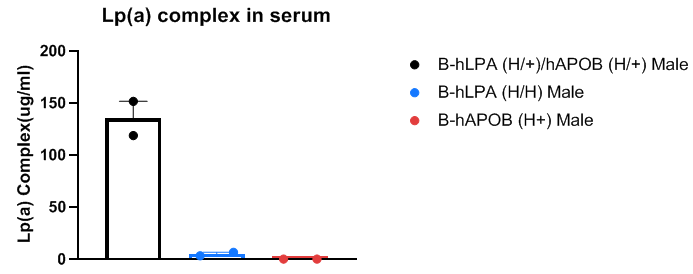B-hLPA/hAPOB mice
| Strain Name |
C57BL/6-Gt(ROSA)26Sortm1(LPA) Bcgen Apobtm1(APOB)Bcgen /Bcgen |
Common Name | B-hLPA/hAPOB mice |
| Background | C57BL/6 | Catalog number | 113427 |
|
Aliases |
AK38, APOA, LP; FCHL2, FLDB, LDLCQ4, apoB-100, apoB-48 | ||
|
NCBI Gene ID |
4018, 338 | ||
- Lp(a) gene encoding apo(a), bound to apoB-100 by noncovalently and covalently way to assembly of the Lp(a) particles. Lp(a) particles are highly polymorphic particles that are structurally similar to but larger than low-density lipoprotein (LDL). Apo(a) have multiple repeated copies of sequences homologous to plasminogen's kringle 4 domain (KIV), followed by a kringle 5-like (KV) domain and a protease-like domain. Therein, KIV2 multiple copies determine apo(a) isoform size, which is inversely correlated with plasma levels. The Lp(a) concentration is heterogeneous and, to a major extent, controlled by genetics. Other factors such as ethnicity and race, medical and environmental conditions also play roles in Lp(a) regulation. Lp(a) has been associated with increased risks of atherosclerosis, thrombosis, and aortic valve calcification.
- APOB is the main apolipoprotein of chylomicrons and low density lipoproteins. It occurs in plasma as two main isoforms, apoB-48 and apoB-100, which encoded by a single gene APOB, the shorter apoB-48 protein is produced after RNA editing of the apoB-100 transcript at residue 2180 (CAA->UAA) and early translation termination. Apob-48 is synthesizedin gut and apoB-100 in the liver.
- B-hLPA/hAPOB mice were obtained by mating B-hLPA mice (112723) and B-hAPOB mice (112951).
- The mice can be used for preclinical pharmacodynamics studies of target-related disease.
Gene targeting strategy for B-hLPA/hAPOB mice.
- The full coding sequences of human LPA gene that is driven by ALB promoter was inserted into the Gt(ROSA)26Sor gene locus site. And there’s no LPA gene in the mouse genome sequence.
- The exons 1-29 of mouse Apob gene that encode the whole molecule (ATG to STOP codon), including 5’UTR and 3’UTR were replaced by human counterparts in B-hAPOB mice. The human APOB expression is driven by human APOB promoter, while mouse Apob gene transcription and translation will be disrupted.
- B-hLPA/hAPOB mice were obtained by mating B-hLPA mice (112723) and B-hAPOB mice (112951).

Strain-specific Apo(a) expression analysis in wild-type C57BL/6JNifdc mice and homozygous humanized B-hLPA/hAPOB mice by ELISA. Serum was collected from wild-type C57BL/6JNifdc mice (+/+) and homozygous B-hLPA/hAPOB mice (H/H) (n=3, 6 weeks old, female; n=3, 6 weeks old, male). The expression level of human Apo(a) was analyzed by ELISA (Abcam, ab212165). Human Apo(a) was exclusively detectable in homozygous B-hLPA/hAPOB mice, but not in wild-type C57BL/6JNifdc mice. Values are expressed as mean ± SEM.

Strain-specific APOB expression analysis in wild-type C57BL/6JNifdc mice and homozygous humanized B-hLPA/hAPOB mice by ELISA. Serum was collected from wild-type C57BL/6JNidfc mice (+/+) and homozygous B-hLPA/hAPOB mice (H/H) (n=3, 6 weeks old, female; n=3, 6 weeks old, male). Expression level mouse and human APOB were analyzed by ELISA (Mouse: Abcam, ab230932; Human: ab108807). Human APOB was exclusively detectable in homozygous B-hLPA/hAPOB mice, but not in wild-type C57BL/6JNidfc mice. Values are expressed as mean ± SEM.

Strain-specific Lp(a) complex expression analysis in heterozygous humanized B-hLPA/hAPOB mice by ELISA. Serum was collected from heterozygous B-hLPA/hAPOB mice (H/+) (n=2, 11 weeks old, male), heterozygous B-hAPOB mice (H/+) (n=2, 11 weeks old, male), and homozygous B-hLPA mice (H/H) (n=2, 8 weeks old, male). Lp(a) complex can be detected in heterozygous humanized B-hLPA/hAPOB mice, but not in homozygous B-hLPA mice and heterozygous B-hAPOB mice. Note: Data was shared from a client. Values are expressed as mean ± SEM.
Biochemistry analysis

Biochemical test of B-hLPA/hAPOB mice. Values are expressed as mean ± SD.

Complete blood count (CBC) of B-hLPA/hAPOB mice. Values are expressed as mean ± SD.




The pathological results of major tissues and organs showed no significant difference from those of wild-type C57BL/6 mice.












 京公网安备:
京公网安备: